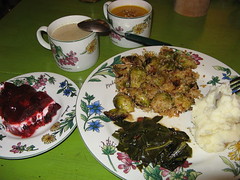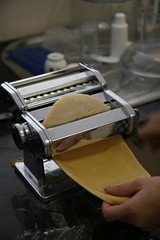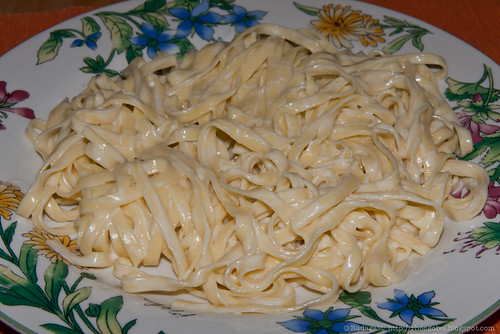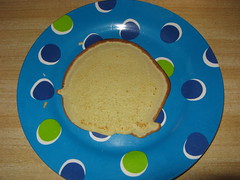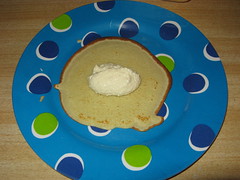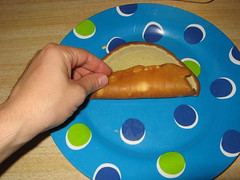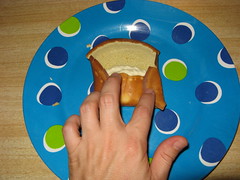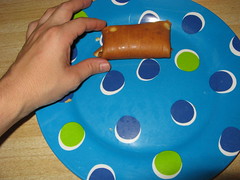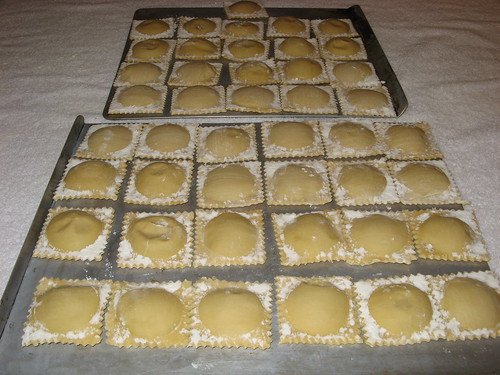My SO and I decided to diversify our pepper planting this summer by growing some Jamaican Hot Chocolate peppers, in addition to the jalapeños that we usually grow. Jamaican Hot Chocolates are very pretty (they ripen to a nice chocolate brown), but as they're a close relative of habaneros, they're
extremely hot: they score about 100,000 to 200,000
scoville units, whereas jalapeños score around 2,000 to 10,000 scoville units. A friend of ours grew the same peppers, and reported that touching his eye after cutting one pepper in half resulted in hours of searing pain.
We, quite honestly, didn't know what to do with the peppers. So, they piled up on our counter; eventually we decided that we had to do something with them, and thus we created "Radagast and SO's Summer Bounty Super-Hot Hot Sauce." We took inspiration from a few
hot sauce recipes we found online.
We've never used hot sauces regularly before, but we both love this hot sauce. While it's packed with heat (a tiny dab on a spoonful of rice is enough to make our mouths burn), it has a rich smoky flavor that goes well with many dishes, and it doesn't have the strong vinegar flavor that some hot sauces do. So far we've added it to tuna melts, mac and cheese, roasted asparagus, tomato soup, tomato pasta sauce, and had it on chips, and it's been great in everything (note: we're adding tiny amounts to each of these; often less than 1/8 of a teaspoon to a full serving). We can't wait to add it to a pot of chili.
Since we never thought we'd be adding hot sauce to our recipes, this is this week's
end-of-the-week recipe blogging post.
CAUTION: See safety instructions before working with the peppers.20 Jamaican Hot Chocolate peppers, seeded, deveined, and quartered (habaneros would probably be a fine substitution)
18 red jalapeños, seeded, deveined, and quartered
1 pound whole tomatoes, peeled and seeded
1 20-oz can crushed pineapple, in juice
~20 garlic cloves, minced or pressed with a garlic press
2 1/4 cups white vinegar
1 cup brown sugar
1/2 cup dry mustard powder
4 tablespoons paprika (we used a mix of smoked Spanish and regular)
3 tablespoons kosher salt
2 tablespoons ground black pepper
2 tablespoons cumin
1 teaspoon ground coriander
1 teaspoon ground cumin
1 teaspoon ground allspice
0. Get out all kitchen implements that you may require during cooking before handling any of the peppers. Prepare a vegetable oil rinse station (see below), have plates or other washable spoon rests ready near all work areas, put on your gloves and goggles, and have paper towels at the ready so you can hold non-washable items without getting capsaicin all over them.
1. Add all ingredients to a blender and blend until smooth. This may require multiple batches of blending. Ensure that the top of the blender is firmly attached (and any holes are sealed) to prevent sauce from being flung around the room.
2. Carefully transfer the blended ingredients to a pot that is large enough to have absolutely no risk of the sauce boiling over.
3. Bring the sauce to a simmer over medium-high heat, and simmer for 20 minutes on the lowest possible heat that will maintain the simmer. Be extremely careful not to bring the sauce to a full boil, as that will drastically increase the risk that sauce gets splattered all over you and your kitchen.
4. Carefully decant the sauce into prepared jars (see notes).
5. Thoroughly wash anything that you touched after handling the peppers before removing your gloves; we recommend running items through a dishwasher multiple times.
6. Remove your gloves and throughly wash your hands with vegetable oil, followed by soap and water.
Safety instructions:
The compound in peppers that causes the "heat" is capsaicin. Capsaicin is lipophilic, which means that it can diffuse straight through your skin and cause pain wherever you come into contact with it (hands, face, eyes, genitals, etc.). Capsaicin does not wash off completely with regular soap and water, and thus I would
never recommend handing cut Jamaican Hot Chocolates or habaneros with anything but gloved hands (we used latex gloves). In addition, I'd strongly recommend wearing goggles, a long-sleeved shirt, long pants, and socks when making this hot sauce. It wouldn't be going overboard to consider a face-shield and a respirator; at the very least make sure your work area is extremely well ventilated, as even the fumes are strong.
Probably the best method to get capsaicin off of your skin is to scrub with pure vegetable oil. If you do accidentally get capsaicin on your skin (you'll know if you do), immediately wash the affected area with vegetable oil, followed by soap and water (note, however, that this will not remove all the capsaicin, and there will likely be nothing you can do to stop the pain).
Make absolutely sure that all utensils, pots, and other items you touch with capsaicin-tainted hands are washed thoroughly before handling them bare-handed. Even after wearing gloves to cook the entire dish, we wash our hands with vegetable oil first, followed by soap, and try to refrain from touching sensitive parts of our bodies for the rest of the day.
Notes:
Peppers can vary widely in the amount of capsaicin they contain. We would thus suggest that you assume that you're using the hottest peppers ever grown, and taste only the tiniest dab of your final hot sauce before trying it in larger quantities. We find that, with our peppers, a dab the size of half a rice grain is plenty to flavor an entire chip (though note that we're relative wimps when it comes to spice).
This recipe makes more than six cups of hot sauce. To store the sauce, we suggest canning it. While we'll leave it up to other sources to provide full canning protocols, what we do is boil clean jars, their lids, and any implements we'll need to handle the jars and put sauce into them (including tongs and a funnel) for 10 minutes in a covered pot, then turn off the heat and leave the pot covered until we're ready to use the jars. When we're ready to decant the sauce we remove the jars from the pot with tongs, ladle the piping-hot hot sauce into the jars and immediately seal them with lids. We let the jars cool at room temperature before labeling them and moving them to the fridge.
And, as a final note, we have no idea how important the various spices are to the final flavor. Given the small quantities of sauce required to flavor items, we're probably approaching homeopathic dilutions for some of the spices; thus, it's likely that at least some of the spices could probably be left out without affecting the flavor.
